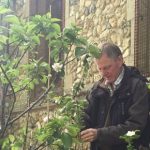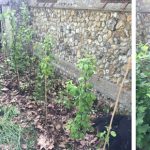Meet Tim Lawrance-Owen, leader of the Graylingwell community garden since 2012. Modestly, Tim says “I’m not a good gardener but I know about making plants grow”.
And he’s right about that! In the Graylingwell temporary community garden, which was closed as planned in 2015, there were lots of amazing and old heritage orchard trees from the 1930s. Most were too old to survive the new development and would be felled. So the community gardeners, under the watchful eye of Tim, first extensively pruned the trees to get new growth and then from that new growth grafted the trees to preserve them and make sure they survive for future generations to enjoy.
Tim told me, “The only trees surviving in the old orchard were the long-living trees: apples and pears. They are the heritage varieties which were bought in the 1930s from Crawley. It is quite exciting because we are not 100% sure which heritage varieties we have saved and as soon as we get fruit, I will take them to the national fruit collection in Kent so we can name the varieties we have!”
Back in 2012, under Tim’s guidance, the Graylingwell temporary community garden was cleared of brambles, grew, thrived and even won three awards in the RHS Britain in Bloom ‘It’s Your Neighbourhood’ category (2012-establishing, 2013- thriving, 2014- outstanding)! He says, “This is a voluntary role, and I enjoy it. I have a real passion for building community in a non-threatening environment and inspiring people. Absolutely anyone can come along and join in … they could write out labels, have a cup of coffee or do some gardening! It is a great way of getting people out of their houses and meeting others.”
The community garden is now closed as the community at Graylingwell Park await access from Linden Homes to the new community orchard and garden, which will be on the eastern boundary of the estate, beyond the Graylingwell Farm House (also known as the Land Superintendents house).
Meanwhile, the grafted trees are safely growing in a temporary location, but the sooner they can be moved the better.
Keen residents are starting to feel downhearted as the wait for access to the new site continues. However, as soon as we get the green light, there are a large number of people, all keen to get their forks, spades and shears into the new site. All they need is a path as wide as a wheelbarrow and the community will set to work to transform the new space from brambles to healthy orchard and gardens.
And we can’t wait!
Read more about the temporary Community Garden at Graylingwell.
A few fun facts
- The kitchen garden was established in 1898 and by 1901 the site had almost achieved self-sufficiency in produce.
- During the Great War, more was spent on seeds than any other time in order to respond to the government’s call to produce more food on the home front.
- “[Some of the fruit and vegetables] used to get sold in the hospital shop or direct to people coming to the garden area and buying them, which was quite nice to see stuff that you’d grown actually being made use of”. Tim Bird [excerpt from Beneath The Water Tower]
- Grayingwell Asylum had orchards and a kitchen garden, which were to the north and north east of the Chapel. They were stocked with fruit trees – apple, plums, pears, quince and medlars – as well as redcurrant, white currant, blackcurrant, raspberries and gooseberries bushes.
- The history of the kitchen gardens and orchards gives the community gardens at Graylingwell Park a wonderful feeling of history and significance, not only because of the role the gardens played in feeding the patients, staff and surrounding community; but also the important part horticulture played in the ‘medical and general treatment of patients’ until 1957.





